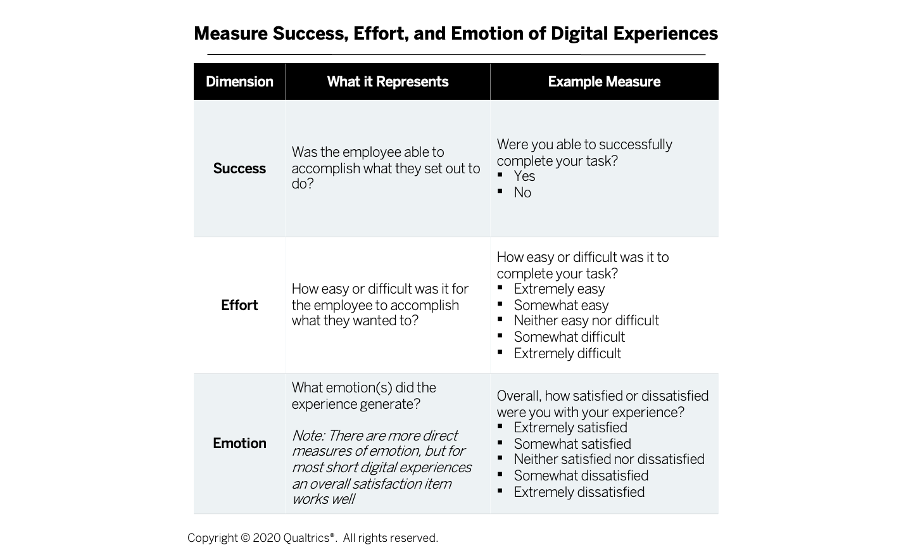The COVID-19 pandemic has accelerated many organizations’ plans to digitize key experiences and there is clearly demand among customers. Naturally, this is influencing the expectations and experiences of employees as well. For example, research during the heart of the pandemic showed that employees around the globe are concerned about the idea of coming back into the physical workplace and are expecting more digital interactions with their employers, leaders, and peers. But even before this global disruption, we’ve seen an undeniable desire among HR and IT leaders to deliver more employee experiences (EX) digitally in order to reduce employee effort, automate simple tasks, redirect employee time and energy to high impact work, and reduce costs.
Many employee experiences are at least partially digital today (e.g., job applications, benefits enrollment, and training sessions). However, at many organizations opportunities remain to make those experiences more effective, and to transition more employee experiences to digital.
Four XM Key Ingredients to Digital EX Success
To date, we’ve worked with hundreds of organizations that are at different stages in their digital journeys. As we examined their XM efforts, we’ve found a set of emerging practices that are helping to accelerate their digital transformation. When it comes to establishing a foundation for strong digital EX, we recommend that EX professionals start with 4 practices:
- Leverage behavioral targeting for key employee personas. One of the promises of a digital workplace is increased personalization. In an ideal world, digital experiences are completely personalized to the individual in a specific situation. But this is often not practical or equitable. Identifying and designing experiences for key employee personas is an effective and practical way to make digital experiences more personalized. Simply put, organizations need to identify what they want to learn from different segments of employees at meaningful moments along their digital journeys. Using behavioral targeting within digital experiences should facilitate more meaningful requests for feedback while also generating higher quality data due to the relevance of the request and the proximity to the experience itself.
- Embed actions within the experience(s). Consider this: data without insights is meaningless and insight without action is pointless. Organizations that have matured their digital practices are effective at directly connecting their digital insights into specific workflows for taking action. If employees, for instance, are spending a significant amount of time on a specific page of the intranet trying to search for benefits information, the system may interrupt their experience to ask what they are trying to find and immediately provide them the link they need. In the background, this experience can be recorded and sent to intranet administrators who can add essential content and function where employees need it. Luckily, digital experiences generally lend themselves well to automatic routing, triggering, and behavior-based intercepts that enable a system of action.
- Instrument always-on listening to inform digital experiences. Employees enter every new experience with a set of expectations and these expectations may come from many different sources outside of our control or purview. For these reasons and others, there may be important aspects of the experience to employees that we may miss, simply because of our different perspective as designers or deliverers of an experience. Always-on listening gives employees the opportunity to provide feedback about digital experiences if and when it’s relevant for them. As you begin to introduce new digital experiences or improve existing experiences, consider the following approaches to always-on listening:
- Introduce a simple, non-invasive intercept asking employees about the digital experience
- Include an open-ended item asking for feedback if and when they decide to engage
- Provide an employee-driven feedback portal within the company intranet
- Measure success, effort, and emotion. Customers perceive their experiences with an organization along three core dimensions: success, effort, and emotion. It is becoming increasingly clear that employees evaluate their experiences at work through a similar lens. While some digital employee experiences, like the candidate experience and onboarding, benefit from tailored measures, many digital experiences are important but fleeting. Since the goal of digitizing EX is often to increase success and reduce effort, success, effort, and emotion is a simple measurement framework that can help XM professionals optimize and improve on these experiences.

Bottom line: Use these four practices to create, iterate, and enhance existing digital experiences to drive employee performance and a better overall employee experience.
Juliana Smith Holterhaus, Ph.D., is a Senior Product XM Scientist with Qualtrics, specializing in Digital XM
Benjamin Granger, Ph.D., is an XM Catalyst with the Qualtrics XM Institute





